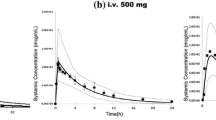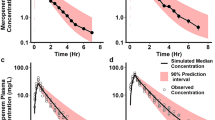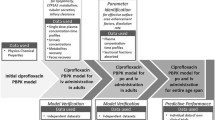Abstract
A physiologically based pharmacokinetic (PBPK) model has been developed for ganciclovir and its prodrug valganciclovir. Initial bottom-up modeling based on physicochemical drug properties and measured in vitro inputs was verified in preclinical animal species, and then, a clinical model was verified in a stepwise fashion with pharmacokinetic data in adult, children, and neonatal patients. The final model incorporated conversion of valganciclovir to ganciclovir through esterases and permeability-limited tissue distribution of both drugs with active transport processes added in gut, liver, and kidney. A PBPK model which accounted for known age-related tissue volumes, composition and blood flows, and renal filtration clearance was able to simulate well the measured plasma exposures in adults and pediatric patients. Overall, this work illustrates the stepwise development of PBPK models which could be used to predict pharmacokinetics in infants and neonates, thereby assisting drug development in a vulnerable patient population where clinical data are challenging to obtain.





Similar content being viewed by others
References
McGavin JK, Goa KL. Ganciclovir: an update of its use in the prevention of cytomegalovirus infection and disease in transplant recipients. Drugs. 2001;61(8):1153–83.
Cvetkovic RS, Wellington K. Valganciclovir: a review of its use in the management of CMV infection and disease in immunocompromised patients. Drugs. 2005;65(6):859–78.
Pescovitz MD, Rabkin J, Merion RM, Paya CV, Pirsch J, Freeman RB, et al. Valganciclovir results in improved oral absorption of ganciclovir in liver transplant recipients. Antimicrob Agents Chemother. 2000;44(10):2811–5.
Humar A, Snydman D. Cytomegalovirus in solid organ transplant recipients. Am J Transplant. 2009;9:S78–86.
Vaziri S, Pezhman Z, Sayyad B, Mansouri F, Janbakhsh A, Afsharian M, et al. Efficacy of valganciclovir and ganciclovir for cytomegalovirus disease in solid organ transplants: a meta-analysis. J Res Med Sci Off J Isfahan Univ Med Sci. 2014;19(12):1185–92.
Paya C, Humar A, Dominguez E, Washburn K, Blumberg E, Alexander B, et al. Efficacy and safety of valganciclovir vs. oral ganciclovir for prevention of cytomegalovirus disease in solid organ transplant recipients. Am J Transplant. 2004;4(4):611–20.
Kim I, Chu XY, Kim S, Provoda CJ, Lee KD, Amidon GL. Identification of a human valacyclovirase: biphenyl hydrolase-like protein as valacyclovir hydrolase. J Biol Chem. 2003;278(28):25348–56.
Puente XS, Lopez-Otin C. Cloning and expression analysis of a novel human serine hydrolase with sequence similarity to prokaryotic enzymes involved in the degradation of aromatic compounds. J Biol Chem. 1995;270(21):12926–32.
Welker H, Farhan M, Humar A, Washington C. Ganciclovir pharmacokinetic parameters do not change when extending valganciclovir cytomegalovirus prophylaxis from 100 to 200 days. Transplantation. 2010;90(12):1414–9.
Caldes A, Colom H, Armendariz Y, Garrido MJ, Troconiz IF, Gil-Vernet S, et al. Population pharmacokinetics of ganciclovir after intravenous ganciclovir and oral valganciclovir administration in solid organ transplant patients infected with cytomegalovirus. Antimicrob Agents Chemother. 2009;53(11):4816–24.
Vaudry W, Ettenger R, Jara P, Varela-Fascinetto G, Bouw MR, Ives J, et al. Valganciclovir dosing according to body surface area and renal function in pediatric solid organ transplant recipients. Am J Transplant. 2009;9(3):636–43.
Bradley D, Moreira S, Subramoney V, Chin C, Ives J, Wang K. Pharmacokinetics and safety of valgancyclovir in pediatric heart transplant recipients aged <4 months submitted for publication. 2015.
Jorga K, Chavanne C, Frey N, Lave T, Lukacova V, Parrott N, et al. Bottom-up meets top-down: complementary PBPK and popPK modeling for regulatory approval of dosing algorithm of valganciclovir in very young children. Clinical Pharmacology & Therapeutics (submitted). 2016.
Rowland M, Peck C, Tucker G. Physiologically-based pharmacokinetics in drug development and regulatory science. Annu Rev Pharmacol Toxicol. 2011;51:45–73.
Leong R, Vieira M, Zhao P, Mulugeta Y, Lee C, Huang S-M, et al. Regulatory experience with physiologically based pharmacokinetic modeling for pediatric drug trials. Clin Pharmacol Ther. 2012;91(5):926–31.
Abdel-Rahman SM, Amidon GL, Kaul A, Lukacova V, Vinks AA, Knipp GT. Summary of the National Institute of Child Health and Human Development—best pharmaceuticals for Children Act Pediatric Formulation Initiatives Workshop—Pediatric Biopharmaceutics Classification System Working Group. Clin Ther. 2012;34(11):S11–24.
Kearns GL. Developmental pharmacology—drug disposition, action, and therapy in infants and children. N Engl J Med. 2003.
Tayman C, Rayyan M, Allegaert K. Neonatal pharmacology: extensive interindividual variability despite limited size. J Pediatric Pharmacol Ther. 2011;16(3):170–84.
Adachi M, Sampath J, Lan LB, Sun D, Hargrove P, Flatley R, et al. Expression of MRP4 confers resistance to ganciclovir and compromises bystander cell killing. J Biol Chem. 2002;277(41):38998–9004.
Lee W, Kim RB. Transporters and renal drug elimination. Annu Rev Pharmacol Toxicol. 2004;44:137–66.
International Transporter C, Giacomini KM, Huang SM, Tweedie DJ, Benet LZ, Brouwer KL, et al. Membrane transporters in drug development. Nat Rev Drug Discov. 2010;9(3):215–36.
Maubon N, Le Vee M, Fossati L, Audry M, Le Ferrec E, Bolze S, et al. Analysis of drug transporter expression in human intestinal Caco-2 cells by real-time PCR. Fundam Clin Pharmacol. 2007;21:659–63.
Prime-Chapman H, Fearn R, Cooper A, Moore V, Hirst B. Differential multidrug resistance-associated protein 1 through 6 isoform expression and function in human intestinal epithelial Caco-2 cells. J Pharm Exp Ther. 2004;311:476–84.
Tanihara Y, Masuda S, Sato T, Katsura T, Ogawa O, Inui K. Substrate specificity of MATE1 and MATE2-K, human multidrug and toxin extrusions/H(+)-organic cation antiporters. Biochem Pharmacol. 2007;74(2):359–71.
Sugawara M, Huang W, Fei YJ, Leibach FH, Ganapathy V, Ganapathy ME. Transport of valganciclovir, a ganciclovir prodrug, via peptide transporters PEPT1 and PEPT2. J Pharm Sci. 2000;89(6):781–9.
Ito K, Suzuki H, Horie T, Sugiyama Y. Apical/basolateral surface expression of drug transporters and its role in vectorial drug transport. Pharm Res. 2005;22(10):1559–77.
Hilgendorf C, Ahlin G, Seithel A, Artursson P, Ungell A-L, Karlsson J. Expression of thirty-six drug transporter genes in human intestine, liver, kidney, and organotypic cell lines. Drug Metab Dispos. 2007;35(8):1333–40.
Asano-Mori Y, Kanda Y, Oshima K, Watanabe T, Shoda E, Motokura T, et al. Pharmacokinetics of ganciclovir in haematopoietic stem cell transplantation recipients with or without renal impairment. J Antimicrob Chemother. 2006;57(5):1004–7.
Spector SA, Busch DF, Follansbee S, Squires K, Lalezari JP, Jacobson MA, et al. Pharmacokinetic, safety, and antiviral profiles of oral ganciclovir in persons infected with human immunodeficiency virus: a phase I/II study. AIDS Clinical Trials Group, and Cytomegalovirus Cooperative Study Group. J Infect Dis. 1995;171(6):1431–7.
Brown F, Banken L, Saywell K, Arum I. Pharmacokinetics of valganciclovir and ganciclovir following multiple oral dosages of valganciclovir in HIV- and CMV-seropositive volunteers. Clin Pharmacokinet. 1999;37(2):167–76.
Acosta EP, Brundage RC, King JR, Sanchez PJ, Sood S, Agrawal V, et al. Ganciclovir population pharmacokinetics in neonates following intravenous administration of ganciclovir and oral administration of a liquid valganciclovir formulation. Clin Pharmacol Ther. 2007;81(6):867–72.
Herrera-Ruiz D, Wang Q, Cook T, Knipp G, Gudmundsson O, Smith R, et al. Spatial expression patterns of peptide transporters in the human and rat gastrointestinal tracts, Caco-2 in vitro cell culture model, and multiple human tissues. AAPS J. 2001;3(1):100–11.
Stefanidis D, Brandl M. Reactivity of valganciclovir in aqueous solution. Drug Dev Ind Pharm. 2005;31(9):879–84.
Simulations Plus, Inc., GastroPlus user manual v9.0. Lancaster, California 93534, 2015.
Anderson RD, Griffy KG, Jung D, Dorr A, Hulse JD, Smith RB. D J, A D, JD H, RB S. Ganciclovir absolute bioavailability and steady-state pharmacokinetics after oral administration of two 3000-mg/d dosing regimens in human immunodeficiency virus- and cytomegalovirus-seropositive patients. Clin Ther. 1995;17(3):425–32.
Mooij MG, de Koning BAE, Lindenbergh-Kortleve DJ, Simons-Oosterhuis Y, van Groen BD, Tibboel D, et al. Human intestinal PEPT1 transporter expression and localization in preterm and term infants. DRUG METABOLISM AND DISPOSITION. 2016.
Author information
Authors and Affiliations
Corresponding author
Electronic supplementary material
Below is the link to the electronic supplementary material.
Online Resource 1
(DOCX 266 kb)
Online Resource 2
(DOCX 40 kb)
Online Resource 3
(DOCX 295 kb)
Online Resource 4
(DOCX 1278 kb)
Online Resource 5
(DOCX 984 kb)
Rights and permissions
About this article
Cite this article
Lukacova, V., Goelzer, P., Reddy, M. et al. A Physiologically Based Pharmacokinetic Model for Ganciclovir and Its Prodrug Valganciclovir in Adults and Children. AAPS J 18, 1453–1463 (2016). https://doi.org/10.1208/s12248-016-9956-4
Received:
Accepted:
Published:
Issue Date:
DOI: https://doi.org/10.1208/s12248-016-9956-4




